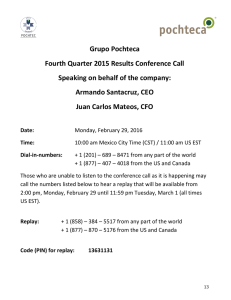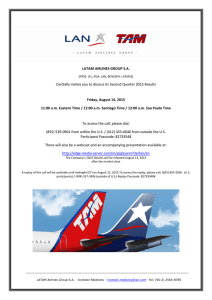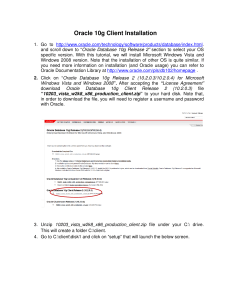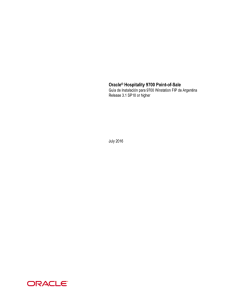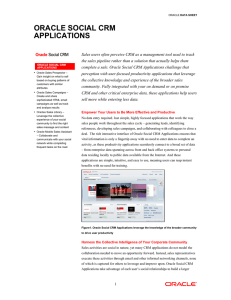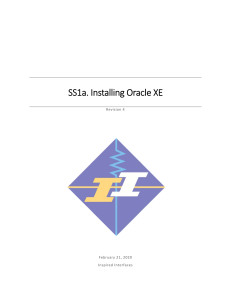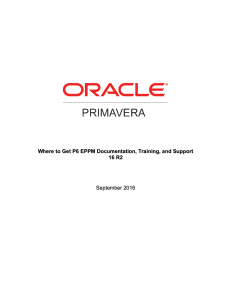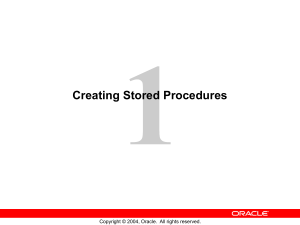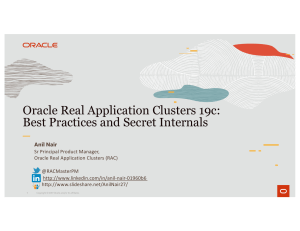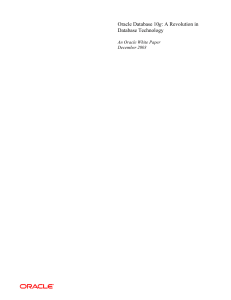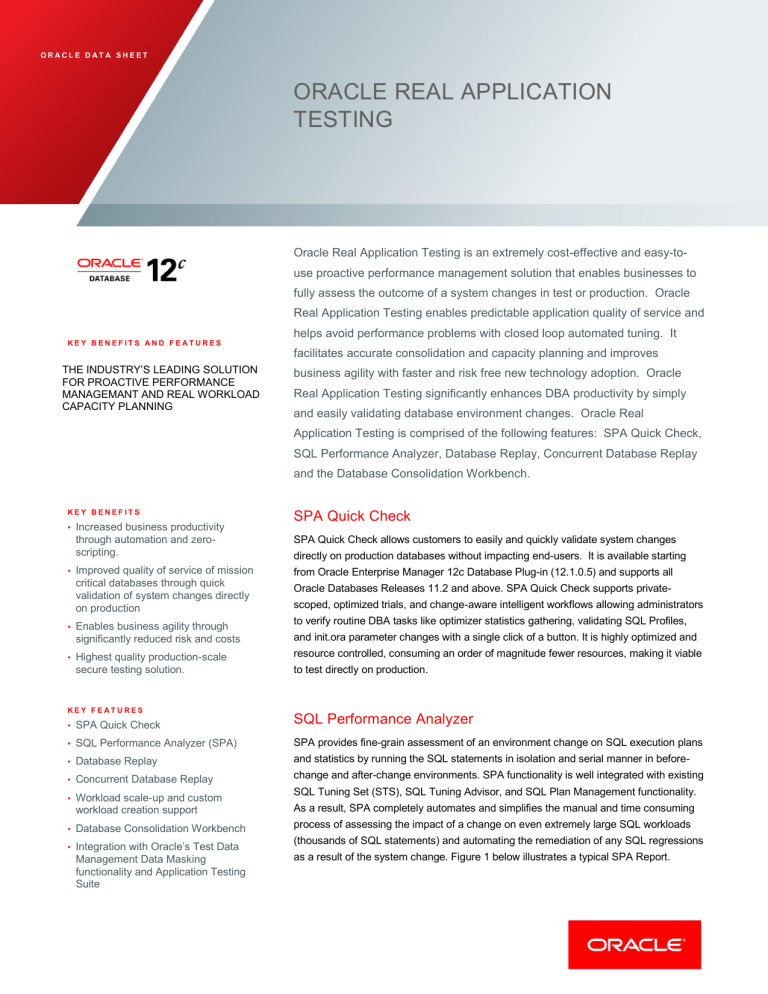
ORACLE DAT A SHEET ORACLE REAL APPLICATION TESTING Oracle Real Application Testing is an extremely cost-effective and easy-touse proactive performance management solution that enables businesses to fully assess the outcome of a system changes in test or production. Oracle Real Application Testing enables predictable application quality of service and helps avoid performance problems with closed loop automated tuning. It KEY BENEFITS AND FEATURES facilitates accurate consolidation and capacity planning and improves THE INDUSTRY’S LEADING SOLUTION FOR PROACTIVE PERFORMANCE MANAGEMANT AND REAL WORKLOAD CAPACITY PLANNING business agility with faster and risk free new technology adoption. Oracle Real Application Testing significantly enhances DBA productivity by simply and easily validating database environment changes. Oracle Real Application Testing is comprised of the following features: SPA Quick Check, SQL Performance Analyzer, Database Replay, Concurrent Database Replay and the Database Consolidation Workbench. KEY BENEFITS • • • • Increased business productivity through automation and zeroscripting. Improved quality of service of mission critical databases through quick validation of system changes directly on production Enables business agility through significantly reduced risk and costs Highest quality production-scale secure testing solution. KEY FEATURES SPA Quick Check SPA Quick Check allows customers to easily and quickly validate system changes directly on production databases without impacting end-users. It is available starting from Oracle Enterprise Manager 12c Database Plug-in (12.1.0.5) and supports all Oracle Databases Releases 11.2 and above. SPA Quick Check supports privatescoped, optimized trials, and change-aware intelligent workflows allowing administrators to verify routine DBA tasks like optimizer statistics gathering, validating SQL Profiles, and init.ora parameter changes with a single click of a button. It is highly optimized and resource controlled, consuming an order of magnitude fewer resources, making it viable to test directly on production. • SPA Quick Check SQL Performance Analyzer • SQL Performance Analyzer (SPA) SPA provides fine-grain assessment of an environment change on SQL execution plans • Database Replay and statistics by running the SQL statements in isolation and serial manner in before- • Concurrent Database Replay change and after-change environments. SPA functionality is well integrated with existing • Workload scale-up and custom workload creation support SQL Tuning Set (STS), SQL Tuning Advisor, and SQL Plan Management functionality. As a result, SPA completely automates and simplifies the manual and time consuming • Database Consolidation Workbench process of assessing the impact of a change on even extremely large SQL workloads • Integration with Oracle’s Test Data Management Data Masking functionality and Application Testing Suite (thousands of SQL statements) and automating the remediation of any SQL regressions as a result of the system change. Figure 1 below illustrates a typical SPA Report. ORACLE DAT A SHEET RELAT ED PRODUCTS Real Application Testing delivers maximum benefits when used with the following Oracle products: • Oracle Diagnostics Pack • Oracle Tuning Pack • Oracle Test Data Management Pack • Oracle Database Lifecycle Management Pack Figure 1. SQL Performance Analyzer Report . Examples of usage for SPA include: Database upgrade, patches, and initialization parameter changes Configuration changes to the operating system, hardware, or database Schema changes such as adding new indexes, partitioning or materialized views Validating optimizer statistics refresh or SQL tuning actions Exadata simulation for DW/DSS workloads Database consolidation to a single or Container Database Database migration to Cloud Database Replay Database Replay workload capture is performed at the database server level and therefore can be used to assess the impact of any system change or use case in the database tier such as: Database upgrades, patches, parameter, schema changes Configuration changes such as conversion from a single instance to RAC, ASM Storage, network, interconnect changes, Operating system and hardware migrations (including to Exadata) Database consolidation to a single or Container Database Database migration to cloud Workload stress testing, capacity planning, and scale-up testing Database Replay workflow consists of the following three phases that are described below: i. Workload Capture When workload capture is enabled, all external client requests directed to the Oracle server are stored into compact “capture” files on the database host file system while incurring negligible overhead. These files contain all relevant information about the call needed for replay such as SQL text, bind values, wall clock time, SCN, etc. The workload that has been captured on Oracle Database Release 9.2.0.8.0 and higher can be replayed on Oracle Database Release 11g and higher. ii. Workload Replay Before performing workload replay, the test system has the intended system change applied and database restored to the point in time before the capture. Once replay is 2 ORACLE REAL APPLICATION TESTING ORACLE DAT A SHEET initiated, a special client program called the “replay client” replays the workload from the processed files. It submits calls to the database with the exact same timing and concurrency as in the capture system and exercises the exact same load on the system as seen in the production environment. iii. Analysis and Reporting Extensive reports that encompass both high-level summary and detailed drill-down information in terms of errors, performance and data divergence are provided to help understand how the replay fared in comparison to capture or other replays. Basic performance comparison reports between replay and capture or other replays are provided and for advanced analysis AWR, ASH, and Replay Compare Period reports are available. Concurrent Database Replay A chosen database consolidation strategy can be validated using Concurrent Database Replay thereby minimizing its associated risk. Concurrent Database Replay supports simultaneous replay of workloads captured from one or multiple systems. These captured workloads can be from any database release or operating system on which workload capture is supported. Some typical use cases for Concurrent Database Replay include: • Schema consolidation into a single database Database consolidation using Oracle Pluggable Databases Testing impact of enabling Resource Manager in a consolidated environment Figure 2 below illustrates Oracle Enterprise Manager 13c, Database Replay Summary Page for a successfully completed concurrent replay. Figure 2: Concurrent Database Replay Summary Page Capacity Planning with Database Replay Database Replay supports workload stress testing, capacity planning, scale-up testing using any of the three methods namely, Time Shifting, Workload Folding, and Schema 3 ORACLE REAL APPLICATION TESTING ORACLE DAT A SHEET Remapping. Time Shifting workload scale-up is useful to conduct system stress testing by adding workloads to an existing workload capture, scheduling them to align their peak activity or as intended, and replaying them concurrently. Workload folding method consists of slicing an existing captured workload into two subsets by specifying a point in time within the captured duration. Then one can double the workload by folding the workload along this specified point-in-time. This is done by submitting simultaneous replays (consolidated replay) of the created subset workloads on the target database. This consolidated database replay effectively allows one to double the current workload without the need to use scripting or supplying binds. Workload Folding scale-up method is suitable for applications where individual transactions are mostly independent of each other. Schema Remapping workload scale-up method enables you to perform scale-up testing by remapping database schemas. This method is useful in cases when you are deploying multiple instances of the same application such as a multi-tenant application, or adding a new geographical area to an existing application. Additionally, Oracle Enterprise Manager Cloud Control 13c provides comprehensive support for the above mentioned Database Replay capacity planning and scale-up testing techniques by providing an intuitive graphical interface. This allows customers to easily and accurately size their system for future growth and consolidation while maintaining or improving their business SLAs. Database Consolidation Workbench Database Consolidation Workbench is a comprehensive end-to-end solution for managing database consolidation. It provides a risk-free and accurate approach to consolidation by eliminating guess work and human errors. The Database Consolidation Workbench uses historical workload metrics - both database and host - to produce an optimal consolidation plan that maps many sources databases to fewer databases (both non-CDB/CDB) or servers on existing or yet to be procured hardware. The Database Consolidation Workbench also automates the entire database consolidation implementation process - saving DBAs the manual error-prone effort of consolidation. The different modes of consolidation supported (e.g., RMAN, Data Pump, Cross Platform Transportable Tablespaces, Data Guard) in the Workbench enable IT administrators and DBAs to implement the chosen consolidation strategy with minimal downtime based on the business needs. The ability to execute the consolidation process in parallel in an automated fashion means that the business can realize consolidation savings faster and reduce operating costs more quickly. After consolidation, the Database Consolidation Workbench uses SQL Performance Analyzer (SPA) to validate the performance of the migrated databases to ensure the required quality of service and SLAs are being met. Real Application Testing and Oracle Data Masking Pack Integration Real Application Testing and Oracle Data Masking Pack functionality integration provides users with the ability to perform secure testing in accordance to data privacy regulations in situations where data in production needs to be shared by non-production users due to organizational or business requirements. 4 ORACLE REAL APPLICATION TESTING ORACLE DAT A SHEET Licensing Real Application Testing features are accessible through Oracle Enterprise Manager, and command-line APIs provided with Oracle Database software. The use of these and other features described in the product licensing documentation requires licensing of the Oracle Real Application Testing option regardless of the access mechanism. CONTACT US For more information about [insert product name], visit oracle.com or call +1.800.ORACLE1 to speak to an Oracle representative. CONNECT W ITH US blogs.oracle.com/oracle facebook.com/oracle twitter.com/oracle oracle.com Copyright © 2016, Oracle and/or its affiliates. All rights reserved. This document is provided for information purposes only, and the contents hereof are subject to change without notice. This document is not warranted to be error-free, nor subject to any other warranties or conditions, whether expressed orally or implied in law, including implied warranties and conditions of merchantability or fitness for a particular purpose. We specifically disclaim any liability with respect to this document, and no contractual obligations are formed either directly or indirectly by this document. This document may not be reproduced or transmitted in any form or by any means, electronic or mechanical, for any purpose, without our prior written permission. Oracle and Java are registered trademarks of Oracle and/or its affiliates. Other names may be trademarks of their respective owners. Intel and Intel Xeon are trademarks or registered trademarks of Intel Corporation. All SPARC trademarks are used under license and are trademarks or registered trademarks of SPARC International, Inc. AMD, Opteron, the AMD logo, and the AMD Opteron logo are trademarks or registered trademarks of Advanced Micro Devices. UNIX is a registered trademark of The Open Group. 0116 5 ORACLE REAL APPLICATION TESTING
